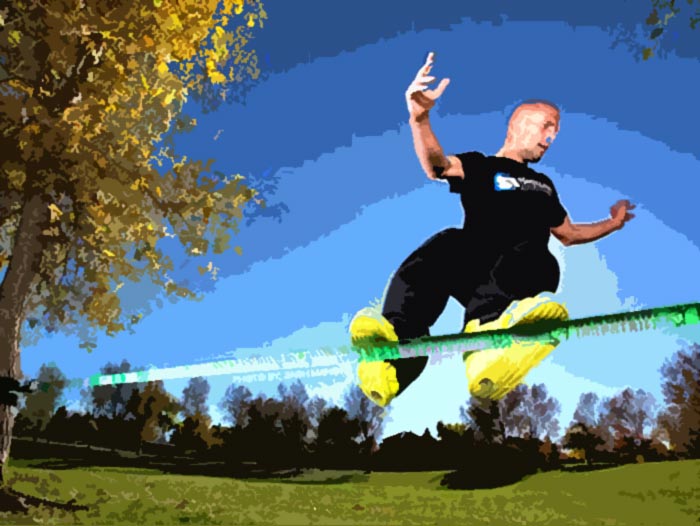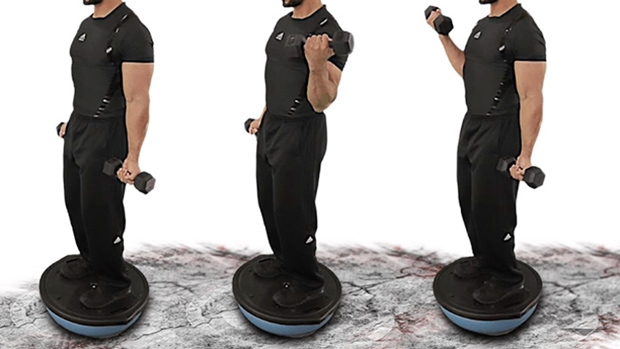Ankle tap tackles are a divisive subject in rugby – both for players and spectators. Delivering an ankle tap can bring down an opposing player running at top speed, often when they are out of range of a full-contact tackle. In a lot of instances, an ankle tap is all that stands between a defending player and a try.
But, if you are on the receiving end of an ankle tap tackle, once you’ve slid to a halt, you’ll probably be annoyed that such an insignificant impact brought you down on your run for glory.
Love them or loath them, ankle taps are a part of rugby, and the truth is there probably isn’t much you can do that will increase your chances of beating one. But that doesn’t mean we can’t try!
The best ankle tap beating strategy is making sure you can outpace the player chasing you down. A well-timed hitch kick or sidestep will help too. But, if you are unlucky enough to get caught, the following exercises and drills may help.
1 – Single leg Romanian deadlifts
This exercise will help develop strength and balance simultaneously, which is exactly what you need if you are going to beat an ankle tap. Make this exercise even more rugby-specific by doing it explosively, loading both the eccentric and the concentric phases at speed. After all, you won’t recover your balance after a tap tackle if you do it slowly.
How to do it:
- Stand with your feet together and dumbbells or a barbell in your hands. Shift your weight over onto one foot. Bend your supporting leg slightly.
- Without rounding your lower back, hinge forward from your hips and lower the weight(s) down the front of your leg as far as your flexibility allows. Extend your other leg out behind you for balance.
- Stand up straight and then repeat.
- Make this exercise harder by standing on a folded exercise mat, cushion, or an inflatable or foam pad.
2 – Squat jump with a single-leg landing
Okay, we’ve made this exercise up, but that doesn’t mean it won’t help you beat a tap tackle. The idea is simple; move from a stable position to an unstable one, and then control your position and regain your balance. That sounds a lot like what you need to do after a tap tackle.
How to do it:
- Stand with your feet about shoulder-width apart. Push your hips back, swing your arms to the rear, and squat down.
- Jump forward as far as you can, using your arms for extra momentum.
- Land on one leg, doing your utmost to stick the landing perfectly.
- Stand on two feet again and repeat, landing on the opposite leg.
3 – Slacklining
Slacklining is possible one of the best ways to develop your balance. As surviving an ankle tap is partly an issue of balance, it’s not inconceivable that slacklining won’t help.

You can buy a slacklining kit for about $50, comprising of the slackline itself, a pair of ratchet straps to tighten it up, and some tree anchors. All you need to do then is suspend the slackline between two suitable trees or posts. Keep your line close to the ground – there is no need to turn this exercise into a death-defying high-wire act!
With your slackline in place, it’s time to start standing and then walking on the line. Because it’s slack, it’s easier to balance on than a tightrope wire. It WILL sway underneath you, but by leaning the opposite way, you should be able to counter that movement.
As well as improving your balance, slacklining is good for joint stability and core strength. It’s good fun too! Suspend your slackline over a pool or river to add an extra dimension to your ankle tap training.
4 – Running on soft sand
Running on soft sand is good for conditioning. Every time the sand shifts under your feet, you waste valuable energy. Kick your interval training up a gear by sprinting on sand. It’s a killer.
But, running on soft sand could also improve the joint stability, strength, and balance you need to beat an ankle tap. As the sand shifts beneath you, you’ll need to react instantly to maintain your forward momentum.
The deeper and softer than sand is, the harder this exercise will be. And by harder, we also mean more effective, both for balance and conditioning.
5 – Wobble board training
The reason that a tap tackle is so devastating is that it causes you to lose your balance while you are running at full speed. Inevitably, this leaves you sprawled on the field, having slid a few yards on your belly first. So, if losing your balance is the problem, better balance may be the solution.
Wobble boards are used by physios and fitness trainers to develop balance and stability. They come in all shapes and sizes, but arguably the best design is a disc with a hemisphere in the middle of the base. This design allows for 360-degree movement.
Another good balance training device is the BOSU ball, which stands for Both Sides Up. BOSU balls resemble half a stability ball fixed to a hard-plastic base. As the name suggests, BOSU balls can be used soft side or hard base side up.
While we aren’t advocating that you start doing your strength workouts on a balance board or a BOSU, as that’s a good way to get ABSOLUTELY NOTHING from your training, you can use these devices to improve balance and agility.

So, forget things like BOSU biceps curls and focus on things like squats, lunges, and standing on one leg. We can’t guarantee that this will make you tap tackle-proof, but it certainly won’t hurt.
6 – Practice recovering after being ankle tapped
Our last strategy for beating ankle taps is probably the best; practice. Grab a teammate and get them to tap tackle you. Do your utmost not to go down. Start off by jogging, or even walking, and increase your speed gradually over a series of workouts. Get them to tap your left and your right ankle so you can practice getting hit from both sides. Initially, they can warn you so you can be prepared for the tackle. But, as you get better, they should do it when you are not expecting it, to make for a more real exercise.
Needless to say, this strategy could take its toll on your body as, inevitably, you are going to end up hitting the deck. But, providing you are warmed-up, you should be okay. After all, you’ll also be expecting the tap so you should be able to roll with it, rather than face-plant into the ground.
If you DO go down, make sure you get back on your feet as fast as you can, just as you would in a game.
The best workouts for rugby are the ones that are most specific. And what could be more specific for beating tap tackles than actually being tap tackled? At the very least, you’ll get used to being ankle tapped, and your partner will get better at delivering them. It’s a win-win.
Conclusion
Delivering a successful ankle tap is immensely satisfying. Being brought down by one is much less so. And judging by the lack of information available on how to beat a tap tackle, it seems that, if you are caught by one, it has a very good chance of being successful.
That leaves you with two choices – just accept you are going down or try some new training methods that MIGHT make you a bit more tap tackle-resistant. At the very least, these exercises will enhance your general strength, balance, and agility, and that’s never a bad thing.
At best, you might be the first player to beat ankle taps with training. Make sure you let us know how to get on!


